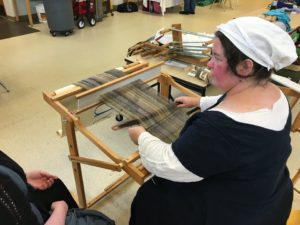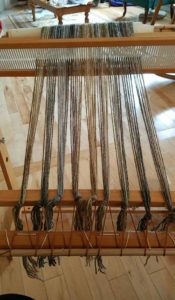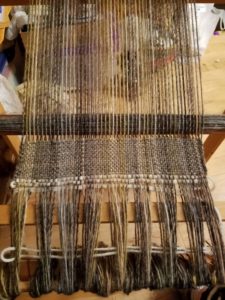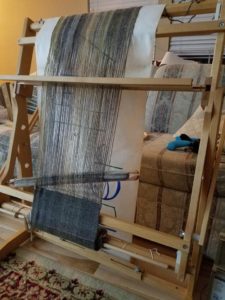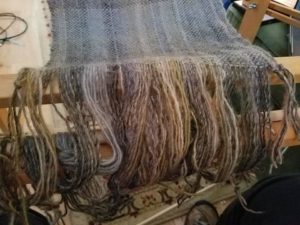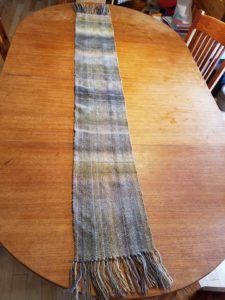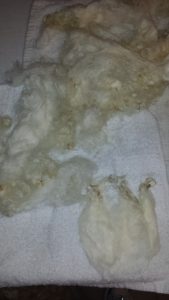A few weeks ago, I was greatly anticipating entering Kingdom Arts & Sciences in 2015 with my warp-weighted loom–something I had never seen anyone work with in An Tir. After the Kingdom event was over, I started eagerly looking at some of the entries that starting appearing on Facebook. I was a little discouraged to see an entry this year that included…yes, a warp-weighted loom. My first reaction was “dang it! I wanted to be first!” Then it was, “Now it’s going to look like I’m copying.” It was, admittedly, a little disheartening, but still left room for my own interpretation. The loom she used was for card weaving, not for fabric. I had a nice chat with my Foster Laurel (whose identity shall remain a mystery for now)…she has been a great sounding board when I have questions or get discouraged on my Artisan Journey (let’s not say Laurel Track…who the hell knows where this journey will end?). I relied on her greatly when I had a personal issue with another member, when I had frustrations with a judging panel, and yesterday, when I was stung by the surprise of someone else doing stuff with the loom that I thought only I was doing.
After she talked me down off the ledge, and I had a night to sleep on it, I realized that my journey and her journey may cross paths, but we are on different journeys. Hers was to do card weaving on a warp-weighted loom; and mine is to make a sheep to shawl project. I even have the wool!
Many thanks to HL Godith of Goosefoot Mead for providing this bag of goodness! This award-winning fleece needs to be washed, carded and spun and will — hopefully — be a finished garment someday.

This is from a sheep named Sprite from the sheering in 2006. She’s been holding onto several fleeces for all these years and was happy to give it a new home for this endeavor. Thanks, Godith!!
Sprite was a Romney-Border Leicester cross and she grew some really nice long-staple locks. When cleaned, it’s just lovely, isn’t it?
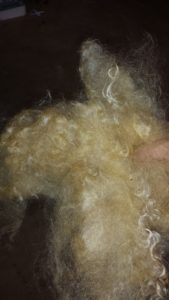
However, before it got to this lovely, white color, the fibers had to be cleaned. This is the gross part. It’s full of burrs, grass, hay, and…yes…poop. Mostly the poop is just on the edges of the fleece–the belly and bum–but the rest of the fleece is oily and dirty. The oil is lanolin, which is the stuff they put into lotions and things, so working with this stuff will certainly keep your hands soft!
There are a few different techniques for washing fleece. Some say use screaming-hot water (140-160 degrees F) and lots of soap (a cup of dish soap per fleece). Others say lukewarm water and a couple ounces of soap are just fine. I tried a few different techniques to see what worked best with this fleece.
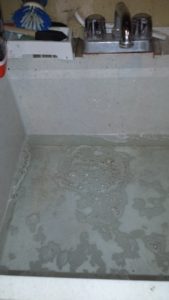
The thing to avoid is turning your fleece into felt. To make felt from wool you need three things: water, heat, and agitation. Swooshing the fibers around in screaming-hot water is the recipe for woolly disaster. Some fleeces will felt as soon as you grab the kettle…others will withstand all kinds of abuse without felting. The trick is to figure out what you can do without turning your lovely fleece into a nasty mess. 
So first you run some water into your wash basin (sink, bucket, pot…whatever you want to use) and put some soap into the water. You put the soap in after the water is run–you don’t want suds, you just want the soap in the water, and gently swish it around. Take a couple handfuls of the dirty fiber–you only want to wash a few ounces at a time–and pull the visible grass, burrs and poo from the fiber.
Place the fiber into the water, and press down gently. Don’t stir or agitate–just make sure it all gets wet. Wait 10 minutes while the oils and dirt come off the hair. Yeah, the water will look gross. It will be an amazing change from the yellow stuff you put in to what you pull out, even after the first soak.
Carefully pull the fiber out and let the water drain out of the wool. Pull the plug on the sink, and refill with water–same temperature as before. If you put hot wool into cold water or vice versa, the temperature change can cause it to felt. Poof! Ruined wool. Add more soap, repeat process.
You can repeat the process a couple more times, washing and rinsing the hairs, pulling any grass or seeds you find as you go. I pinched or rubbed some of the tips to get some of the gross color out of the hairs, but it didn’t all come out (the darkest bits in the lower right of this picture went back into the bath for a bit more washing). When you’re satisfied, lay it out on towels or a sheet to air dry in the shade.
Once dry, you can comb out the fibers to get it ready for spinning. I don’t have wool carders, which start at $50 and go up from there. I opted, instead, to buy a small $7 cat/dog brush to use to comb out the fibers…see how that works. So far it seems to be going OK!
So now I have a pile of fluffy white stuff, ready to spin!
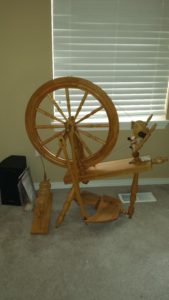
Heide has entrusted me with her amazing spinning wheel, which I will hopefully be able to figure out how to use. I got a very quick tutorial last weekend and hoped enough of it stuck to be able to make some fluffy stuff into string.
Success!




